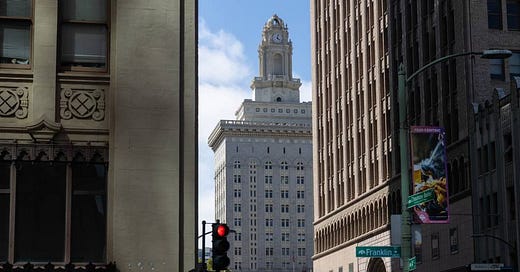What’s in Oakland’s new budget — and what comes next
A step in the right direction, but still not quite the strategic reset Oakland needs
Last week, Oakland City Council passed a two-year, $4.2B budget — three weeks ahead of the deadline. It’s unusually fast for a city known for drawn-out negotiations, and while the budget is a big step in the right direction, it’s still not quite the strategic reset Oakland needs.
Back to basics: Oakland desperately needed a budget rooted in clear priorities and essential services — and that’s largely what we got.
Dubbed the “Nobody’s Happy Budget” for the give-and-take nature of how it came together, the budget focuses on four pillars: public safety, economic development, blight reduction, and safer streets.
Key wins include:
All 25 fire stations stay open
678 sworn police funded (still short of the 700 mandated under Measure NN)
5 police academies (fewer than initially proposed, but larger class sizes)
Investments in safer, cleaner streets: more funding for sideshow prevention, traffic safety, and illegal dumping enforcement, including drones and surveillance cameras
Support for local businesses: more funding for safety ambassadors in key business corridors and new investment in Economic Opportunity Zones
Worth noting: The budget was passed 6-1 with rare alignment across city council — a surprising but welcome change.
Public safety concerns: This budget makes some progress on public safety — but the proposed officer count still falls short of what’s required , and even shorter of what’s actually needed.
Five larger academies can work — but only if they’re filled. The last time OPD managed to fill at least four academies was more than a decade ago.
To get there, Oakland needs a real recruiting and retention strategy: effective marketing, a national recruitment campaign, a retention plan, incentives, and creative programs like returning officer initiatives.
Some of this is included in the $200K allocated for OPD academy outreach — a step in the right direction.
The budget restores five civil safety positions, including intake technicians to free up officers for patrol and field work.
But countless other professional staff positions remain frozen across the police department that directly impact the effectiveness of sworn officers.
Police overtime will also be cut, even though staffing levels remain far below what’s needed.
Big assumptions: While we’ve finally moved away from relying on one-time revenues like grants and asset sales, the new budget banks on revenue that doesn’t exist yet.
This includes $40M in hypothetical parcel taxes that wouldn’t be on the ballot until November 2026.
It also assumed $2.3M from a billboard deal that had yet to be approved by city council, along with $1.7M in business taxes that the city has historically struggled to successfully collect.
Takeaway: Avoiding one bad habit doesn’t excuse doubling down on another.
Oakland isn’t broke: Remember, Oakland takes in more tax revenue per resident than Berkeley, LA, San Diego, San Jose, Fremont, and Long Beach, and more than twice as much as Sacramento.
This budget continues to lean on the “extreme fiscal necessity” provision, which allows city council to sidestep voter-approved funding requirements, like maintaining 700 sworn officers under Measure NN, and still access those funds.
This provision was originally intended for emergencies, but has become standard operating procedure — and we can’t keep using it to bail ourselves out.

What’s the rush: Passing the budget ahead of schedule avoids uncertainty, but puts us at risk in case any of the big revenue assumptions fall apart.
With three weeks to spare, city council could have benefited from some contingency planning.
Specifically, what happens if voters don’t approve the supposed parcel tax in 2026? Or what if state or federal revenues continue to decline?
Right now, the answer seems to be: wait until the mid-cycle budget and revisit those problems later.
The real work starts now: While the budget may look good on paper, success will be in the execution.
As the adage goes: what gets measured, gets managed. Oakland should adopt transparent performance metrics and dashboards that show whether money spent delivers the intended outcomes.
Did we hire the number of officers we budgeted for?
How many recruits started at our police academies and how many graduated?
Were sideshow and dumping interventions actually implemented?
How many businesses opened in activation zones?
Did more safety ambassadors reduce crime and drive sales in business corridors?
What’s next: In July, the city is expected to release a much-needed long-term roadmap for fiscal sustainability.
We’ll continue to monitor what gets implemented, measure results, and hold leaders accountable.
Because budgeting isn’t just about numbers. It’s about whether we’re building a thriving, sustainable city that works.





Thank you as always… especially the comment, “We’ll continue to monitor what gets implemented, measure results, and hold leaders accountable..”